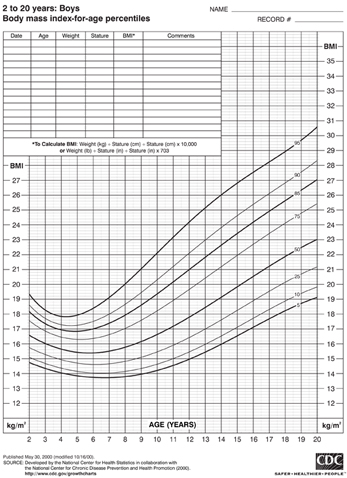- BMI is a ratio of a person’s height and weight.
- Growth charts track BMI over time and are associated with classifications of underweight, normal, overweight, or obese which may not be an indicator of health.
- A high BMI in combination with poor eating habits and lack of exercise can mean that a person is at risk for health-related problems such as high blood pressure or diabetes.
- A low BMI in combination with decreased food intake or skipping meals can mean that a person is at risk for health-related problems such as a compromised immune system and malnutrition.
 What is Body Mass Index (BMI)?
What is Body Mass Index (BMI)?
BMI is a ratio of a person’s height and weight, and does not directly measure a person’s health status, muscle, bone, body fat, or body water. A high BMI in combination with poor eating habits and lack of exercise can mean that a person is at risk for health-related problems such as high blood pressure and diabetes. A low BMI in combination with decreased food intake or skipping meals and snacks can mean that a person is at risk for health-related problems such as a compromised immune system and malnutrition.
How is BMI measured?
To figure out a teen’s BMI, an accurate weight and height is needed. BMI is then measured using the mathematical formula shown here:
Your child’s weight (in pounds) times 703 divided by his height (in inches) squared.
You can use online calculators to figure out BMI here: Children and Teens (age 2-19) and Adults (age 20+).
You can also use this link to determine a teen’s BMI.
 How is BMI interpreted?
How is BMI interpreted?
Once a teen’s BMI has been calculated, it can be interpreted using growth charts designed by the Center for Disease Control (CDC). These charts (one for boys and one for girls, aged 2-20) are used to convert a teen’s BMI into a percentile. This percentile tells us how a teen has been growing over the years. The BMI is then classified using the following scale:
| BMI percentile | Category |
| less than 5th percentile | Underweight |
| between 5th and 85th percentile | Normal weight |
| between 85th and 95th percentile | Overweight |
| greater than 95th percentile | Obese |
The best way to interpret a teen’s BMI is to track it over time on his growth chart. Teens should stay at about the same BMI percentile during their teen years. If a teen’s BMI percentile goes up or down quickly, he should talk with her health care provider to talk about the possible reasons for the change.
What is BMI used for?
BMI is used to identify teens who may be at higher risk for certain health problems. A teen whose BMI falls into the classification of underweight, overweight, or obese should be seen by his health care provider and a registered dietitian to assess risk for any health-related complications and to make sure your child is getting all the nutrients he needs to grow healthy and strong.
What are BMI report cards?
Some schools in the United States are checking weights and heights of students at school, calculating BMI, and sending this information home to parents as a BMI report card. The controversial report cards are used to identify teens who are underweight, overweight, or obese. If your daughter brings home a BMI report card, have her bring it with her when she sees her health care provider and/or registered dietitian so they can explain the information on the card.
What are the limitations of BMI?
BMI is just an estimate of body size, and is not a good indicator of overall health. This is especially true for muscular teens (such as those who exercise or are very athletic). Their weight may be higher because of extra “muscle mass” and not because of extra body fat, and BMI doesn’t take into account how much muscle someone has. Additionally, BMI should be cautiously interpreted in teens that are growing or going through puberty. During these times, weight, height, and body fat change at different times and rates, which can affect BMI. Whether or not your teen eats healthy foods and is physically active is more important to their health than what their BMI classification is.
 Young Men's Health
Young Men's Health